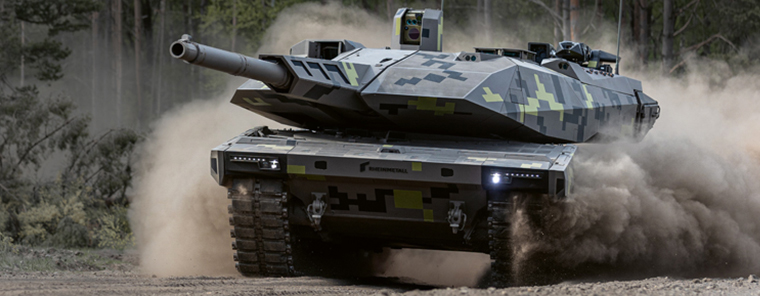

The Panzerkampfwagen V, better known as the Panther, was a German medium tank used during the latter half of WWII. Intended to counter the Soviet T-34 and replace the Panzers III and IV, German tank crews praised the Panther for its mobility, survivability, and firepower. Now, German defense manufacturer Rheinmetall is reviving the Panther name with its new main battle tank.
Unveiled at the Eurosatory 2022 weaponry industry trade fair on June 13, the KF51 Panther Main Battle Tank was described by Rheinmetall CEO Armin Papperger as a “gamechanger.” Although the Panther is based on the hull of the Leopard 2 MBT, the KF51 utilizes an entirely new turret. The Panther’s primary weapon is the 130mm smoothbore Rheinmetall Future Gun System. It features an autoloader with 20 rounds at the ready. Rheinmetall claims on its website that this gives the FGS “an unrivaled rate of fire.” Moreover, Rheinmetall states that the 130mm gun “enables a 50 per cent longer kill range to be achieved (than 120 mm).”
To increase its lethality, the Panther is capable of employing the HERO 120 loitering munition. Developed by Israeli defense company UVision, the HERO 120 allows the Panther to engage targets beyond line-of-sight and can be configured on the tank as dictated by the mission. The Panther is also armed with a 12.7mm (.50 caliber) co-axial machine gun and can be fitted with an optional 7.62mm remote-controlled weapons station. Rheinmetall notes that all weapons are connected through a digital architecture enabling for seamless target engagements and future AI support.

As a main battle tank, the Panther must be able to dish out punishment and also take it. To achieve this, Rheinmetall fitted it with active, reactive, and passive protection. A pre-shot detection system enables the Panther to identify threats and engage them first. Threats from above, which are generally the most deadly to armored vehicles, are addressed by Rheinmetall’s Top Attack Protection System. The company notes that the Panther’s standout protection feature is the active KE protection “which increases protection levels without affecting the system weight.” Finally, the Panther is fully cyber hardened which allows it to operate in a contested electromagnetic spectrum environment.
Despite a combat weight of 59 tonnes, Rheinmetall claims that the Panther provides greater mobility than current systems. Although exact figures for speed are not listed, either on or off road, the company’s website lists a range of over 500km for the Panther.

With Rheinmetall’s constant comparison of the KF51 to current systems, the company appears to be marketing the new tank to operators of the Leopard 2 and other equivalent MBTs. Moreover, the revival of the Panther name, harkening back to the WWII tank, implies certain battlefield qualities that the new tank must live up to. Of course, the timing of the new Panther’s unveiling, with NATO countries investing more heavily in defense as a result of Russia’s invasion of Ukraine, cannot be overlooked either. Time will tell whether the KF51 can live up to its name or not.
